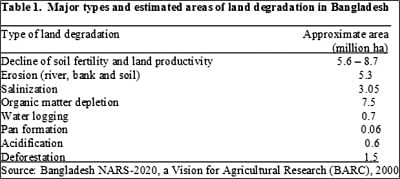Upgrading land productivity

Substantial increase in irrigated area and use of modern rice varieties have led to rapid growth of crop production in Bangladesh in the last decade. Continued and accelerated agricultural growth, which is important both for national economic growth and for poverty alleviation, will require further intensification. There is rising concern, however, that intensive agriculture may be undermining Bangladesh's natural resource base and its environment due mainly to large scale land degradation that is taking place all over Bangladesh. Land degradation leading to change in cropping and crop production is threatening the agricultural sustainability of many countries, especially developing countries with scarce land resources.
Large scale degradation of land resources is a worldwide phenomenon and Bangladesh is no exception to it. Land degradation is deterioration of land qualities commonly caused through improper use by humans and natural disasters. The issue of land degradation is a matter of serious concern for Bangladesh, since it is a threat to crop production and food security. Growing population pressure on land, increased human interference, intensified crop production and poor organic matter and nutrient management have led to severe land degradation problem.
Decline in land qualities is very much visible in Bangladesh. Different land degradation parameters and the changes in cropping patterns over the last few decades show a close relationship with the increased intensity of land use without adoption of adequate soil conservation measures. An evaluation of the land degradation and changes in cropping pattern over the last few decades could provide a basis for future land use planning.
Major factors that lead to land degradation in Bangladesh are: (1) Deforestation in hilly land areas, (2) Shifting cultivation, (3) Intensive crop cultivation, (4) Depletion of organic matter, (5) Lack of manure use, (6) Imbalanced fertilisation, (7) Plant nutrient deficiency, (8) Lack of soil conservation management practices, (9) Excessive withdrawal of groundwater, (10) Lack of adequate moisture, (11) Salinity, (12) Flooding and its duration, (13) Water-logging, (14) Climatic factors, (15) Top-soil erosion, (16) Burial of fertile lands by river eroded coarse materials (sand), etc.
Estimates of areas affected by nutrient depletion and other forms of land degradation summarised in Table 1 are causes of great concern. Intensive crop production with little or no addition of manure to crop fields and inadequate fertilisation resulted in decline of soil fertility, lowering of organic matter level and depletion of nutrients in soils. Organic matter content of most of the soils is as low as 1% to 1.5%, which is very low. The critical level of organic matter in soil is 2%. Erosion rates from most of sloping lands and even of level lands are intensive due to high rainfall. River bank erosion, soil salinity, water-logging, acidification, plough pan formation due to use of country plough and continuous deforestation are on-going phenomena causing serious land-degradation and crop productivity situation in the country.
Human induced landslides caused by clearing of vegetation and shifting cultivation, particularly in hilly regions, pose a serious problem of land degradation. The country also loses forest area at an alarming rate of 3.1% annually due to indiscriminate felling of trees (SRDI, 2004).
Highest priority should be given to combat land degradation when population is increasing with decline of arable lands, which are decreasing at an alarming rate of approximately 1% per year. To maximise and ensure sustainable land use for crop production, the land management strategies that could be adopted are: (1) Proper replenishment of nutrients through balanced use of inorganic fertilisers, (2) Recycling of organic matter and management of soil health care through application of crop residues or animal excreta to the soil, (3) Introduction of grain legumes in cropping patterns along with bio-fertilizers, (4) Use of soil conservation tillage practices in hilly areas to protect loss of top fertile soils, (5) Large scale afforestation, including denuded forest lands, (6) Development of agro-forestry for much needed crop lands, (7) Erection of proper embankment with sluice gates in coastal areas to stop encroachment of saline water to inlands in order to protect the southern coastal lands, which covers roughly 30% of the country's arable land, from intrusion of salinity, (8) Crop adaptation to climate change through use of recently developed crop technologies already released by BRRI, BINA and BARI in flash flood, flood, salinity and drought prone areas of the country, (9) Further development of crop varieties adaptable to climate change vulnerability, (10) Avoiding excess withdrawal of ground water for irrigation needs in dry land areas, (11) Introduction of low water input requiring crop varieties such as maize, pulses, etc. in drought prone areas of the country, and (12) Proper land use planning to optimise crop production and food autarky in the country.
Given the scarcity of land and the continued growth of population, there is no alternative but to continue intensifying agriculture production in Bangladesh. As currently practiced, intensive agriculture is degrading the soil resource base, posing a threat to its sustainability. Detailed studies are necessary to precisely work out the major land areas that are affected by different types of land degradation. Upgrading land productivity, which has been degraded through improper use of soil over a period of time, is vital, with adoption of long-term land management strategy to ensure sustained crop production and food security of the country.

 For all latest news, follow The Daily Star's Google News channel.
For all latest news, follow The Daily Star's Google News channel. 



Comments